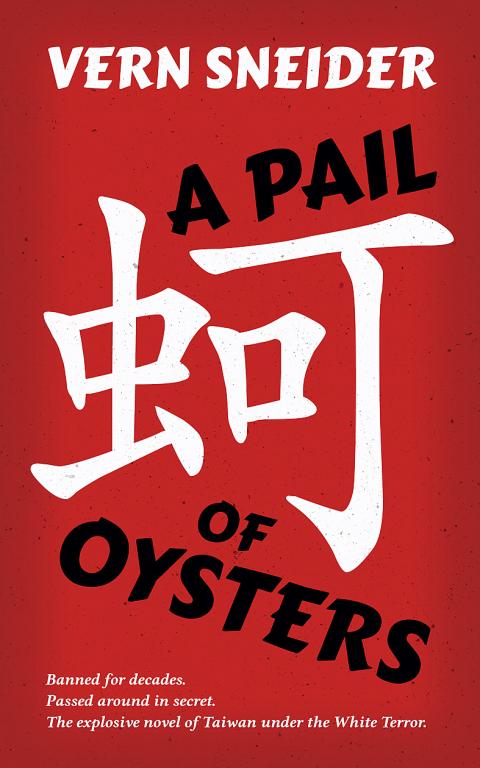Hot on the heels of the success of his debut novel, The Teahouse of the August Moon, American author Vern Sneider spent the summer of 1952 in Taiwan researching his next book.
Ushered in by the 228 Incident of 1947, the White Terror era was at its most brutal at that time as thousands of suspected political dissidents were imprisoned or executed by the ruling Chinese Nationalist Party (KMT).
The resulting book, A Pail of Oysters, was banned in Taiwan, but to Sneider’s dismay, even the US denounced it. It was the McCarthy era, and anything portraying the KMT in a negative light was inevitably painted as pro-communist. It went out of print shortly after.

Photo courtesy of camphor press
While Mandarin and Hoklo (commonly known as Taiwanese) translations have been available since 2003, English editions are rare (rumor has it that pro-KMT students hunted down and destroyed copies from US libraries), with Abebooks.com just listing six copies, ranging from about NT$900 to NT$3,800.
“It’s one of those books that were passed around in secret during the bad old days,” Taiwan and UK-based Camphor Press cofounder Mark Swofford says.
Camphor Press is today releasing the first republishing of the book since the 1950s in digital format, with a print edition to come soon.
“It was suppressed and never got a fair hearing. We want to give it one,” Swofford says.
The book depicts life during White Terror through a variety of characters — most prominently Li Liu, a half-Hakka and half-Aborigine whose family is robbed by KMT soldiers at the beginning of the novel.
But bashing the KMT isn’t the point of the novel, Swofford says.
“It’s a very complex novel, [written] when many people thought it was just the communists versus the KMT,” he says. “It was more of a middle way sort of thing; from the standpoint of the Taiwanese people.”
RE-INTRODUCTION
Late last year, Jonathan Benda, a lecturer at Boston’s Northeastern University, found himself interviewing Sneider’s 85-year-old widow, June.
Benda was familiar with A Pail of Oysters. He read it during his 18-year stay in Taiwan and published an academic paper on it in 2007. Benda says he had once considered republishing it, but lacked the means to do so — and was surprised when Camphor Press asked him to write the introduction to their new edition.
Benda was eager to learn more about the book. In addition to speaking to June, he also dug up old articles and correspondences and obtained copies of the author’s notes through his hometown museum in Monroe, Michigan.
Stationed in Okinawa and Korea, Sneider had never been to Taiwan before the summer of 1952, but the US Army had him study the country at Princeton University in preparation for possible military occupation during the war.
Benda was impressed with the amount of research Sneider’s notes contained — including interviews with people ranging from then-governor K.C. Wu (吳國楨) to pedicab operators and extensive notes on items such as how children are named and blind masseuses. He even had his palm read, which is featured in the novel.
“It’s easy to point out mistakes or problems with his depictions … but I come away thinking that he got a lot of it right,” Benda says.
Through examining letters, Benda found that Sneider had hoped to counter the pervading pro-KMT perception of Taiwan as “Free China” and show how its people were actually suffering under martial law.
“My viewpoint will be strictly that of the Formosan people, trying to exist under that government,” he wrote to George H. Kerr, author of Formosa Betrayed. “And … maybe, in my small way, I can do something for the people of Formosa.”
But although Sneider was critical of the government, he generally gives a balanced picture, including democracy proponents in the KMT and sympathetic soldiers, Benda says.
In addition, the American perspective is shown through the eyes of Ralph Barton, a journalist investigating life in Taiwan under martial law — which corresponds to Sneider’s role, except that the author believed that fiction is a more powerful vehicle through its “emotional pull,” as detailed in his letter to Kerr.
Sneider died in 1981 — too early for any chance to redeem his book, but at least June is able to see it happen.
“She was glad to have this out during her lifetime,” Swofford says.

The Directorate-General of Budget, Accounting and Statistics (DGBAS) told legislators last week that because the Chinese Nationalist Party (KMT) and Taiwan People’s Party (TPP) are continuing to block next year’s budget from passing, the nation could lose 1.5 percent of its GDP growth next year. According to the DGBAS report, officials presented to the legislature, the 2026 budget proposal includes NT$299.2 billion in funding for new projects and funding increases for various government functions. This funding only becomes available when the legislature approves it. The DGBAS estimates that every NT$10 billion in government money not spent shaves 0.05 percent off

Dec. 29 to Jan. 4 Like the Taoist Baode Temple (保德宮) featured in last week’s column, there’s little at first glance to suggest that Taipei’s Independence Presbyterian Church in Xinbeitou (自立長老會新北投教會) has Indigenous roots. One hint is a small sign on the facade reading “Ketagalan Presbyterian Mission Association” — Ketagalan being an collective term for the Pingpu (plains Indigenous) groups who once inhabited much of northern Taiwan. Inside, a display on the back wall introduces the congregation’s founder Pan Shui-tu (潘水土), a member of the Pingpu settlement of Kipatauw, and provides information about the Ketagalan and their early involvement with Christianity. Most

The People’s Republic of China (PRC) was out in force in the Taiwan Strait this week, threatening Taiwan with live-fire exercises, aircraft incursions and tedious claims to ownership. The reaction to the PRC’s blockade and decapitation strike exercises offer numerous lessons, if only we are willing to be taught. Reading the commentary on PRC behavior is like reading Bible interpretation across a range of Christian denominations: the text is recast to mean what the interpreter wants it to mean. Many PRC believers contended that the drills, obviously scheduled in advance, were aimed at the recent arms offer to Taiwan by the

It is a soulful folk song, filled with feeling and history: A love-stricken young man tells God about his hopes and dreams of happiness. Generations of Uighurs, the Turkic ethnic minority in China’s Xinjiang region, have played it at parties and weddings. But today, if they download it, play it or share it online, they risk ending up in prison. Besh pede, a popular Uighur folk ballad, is among dozens of Uighur-language songs that have been deemed “problematic” by Xinjiang authorities, according to a recording of a meeting held by police and other local officials in the historic city of Kashgar in